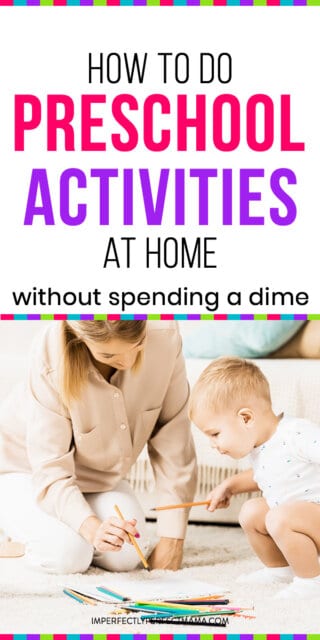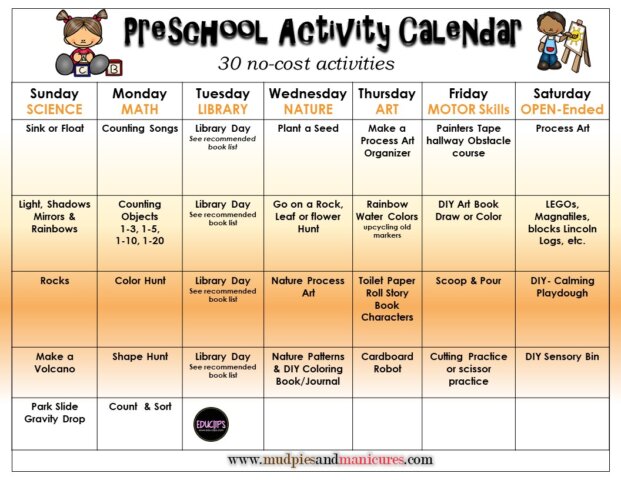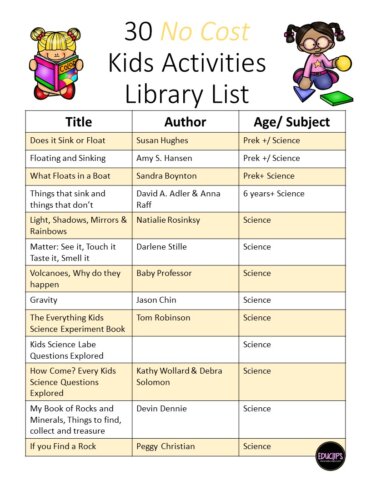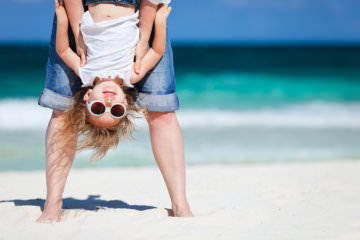Doing preschool activities with your child at home is like setting up an emotional (and academic) trust fund for your kids.

You are building a “fund” of experiences that your child will be able to draw upon for the rest of their life.
The best part is that you can create this trust fund of experiences for your child without spending a dime!
And what’s best about this approach is that the experience is what will count with your child, not the equipment or materials.
Preschool activities like these can be started when your child is around 2.5 years to 3 years old.
How Do I Set Up Preschool Activities at Home?
Don’t worry I made it super easy for you to get started.
Below is an activity calendar of 30 (no cost) preschool activities to do at home.
It’s pretty easy to set up fun preschool activities and it doesn’t have to cost you a dime.
Bookmark this post, read through it and gather materials. Based on what you already have at home choose activities you’d like to try and have fun!
Getting Started:
- Print the Preschool Activity Calendar PDF
- Print the Library Book List PDF
- Go through your house and find materials that can be used for preschool activities (see Gather Materials list below. Set aside items you can re-purpose like TP or paper towel rolls and egg cartons)
- Bookmark this post for future reference
- Have fun!
Gather Materials:
- Round up toys (cars, animals, LEGOs or characters like Peppa Pig, Frozen, Batman, etc.)
- Ingredients to make play-dough (flour, salt, cream of tartar, oil)
- Nature items from the yard (sticks, rocks, leaves & flowers)
- Set aside excess materials; kitchen scraps (carrot & celery tops and seeds), cardboard-lots of cardboard, toilet paper & paper towel rolls, old or broken crayons, dried out markers, painters tape & clear packing tape)
- Office supplies (post-its, copy paper, construction paper, markers, crayons, etc.)
Plan
Here is your plan for the month, all you have to do is gather the materials & choose what you’d like to try.
You may not have all of the materials for each of the activities planned and that’s perfectly fine. On a good week we do one prepared activity per day but sometimes he enjoys the activity so much we repeat it & I skip the other activities I had planned.
If I’ve already prepared them I set it aside for a rainy/ hot day or unexpected play date.
Be Resourceful
If you don’t have all of the items you need you can try calling a friend with kids or grown kids to borrow materials or invite them over for a preschool activities play-date (potluck style where everyone brings something that is needed for the activity). I call these make and take play dates.
Once you know what you have to work with choose the activities that you’d like to start out with.

What Can I Teach My Preschooler at Home?
Preschool at home is a guided exploration. When you do preschool activities at home you are exploring preschool reading, preschool writing, preschool math, preschool science, & gross & fine motor types of experiences.
Children need the freedom to explore the way they like to learn.
School readiness takes time and is actually several years in the making. From the time they are born children are learning to build vocabulary, muscle strength in their bodies (& hands for writing) and learn how to manage all of the information coming at them through their 5 senses.
Preschool Activities to Try
Week 1 Science
Sink or Float
Gather:
- Water proof items (regular hard plastic toys, rocks, sticks, anything you have that will sink or float)
- Bin to hold water or use your bath tub (just be careful items don’t go down the drain)
- Water
- Optional
- Copy Paper
- Marker or sharpie
- Optional: Clear packing tape
This game is excellent for mutli-age households when you don’t want to spend a lot of time prepping or spend money. Grab your materials and fill the bin or tub with water.
TIP: If you plan on doing this activity more than once (we did) faux laminate the papers using clear packing tape to seal out the moisture.
Directions
Predict which items will sink or float. You can predict verbally but most kids work better with visual or tactile aides. Use construction or copy paper and illustrate a stick figure boat sinking (triangle, line & half moon) under the rippled line for water and another paper of the same stick figure boat floating on top of the rippled line.
Kids put the item to be tested on the sink or float paper, then you test it and put the object on the paper that tells what it did.
Week 1 Math
Counting Songs
Numbers 1 to 5
- Once I caught a fish alive
- 5 Green and Speckled Frogs by Mother Goose Playhouse
- 5 Little Monkeys Jumping on the bed
- 5 Little Pumpkins
Numbers 10-20
- This Old Man
- 1,2 buckle my shoe
- How Many Fingers by Super Simple Songs
- The Number Rock by Greg and Steve
Week 1 Library List

Reading & Writing
Preschool Book List
Print this book list for a handy reference on some pretty awesome books.
This list will help you introduce & reinforce the math, science and art for the activity calendar. The public library is generally the best place to go for free books.
If your local library branch doesn’t always have exactly what you’re looking for you can call around nearby libraries or worst case scenario find something similar. If you have a used Book Store in your area those can be great too but they may cost some money unless they have a free section.
Use the books as a low-prep introduction to your activity. Kids love repetition so we re-read often and it helps reinforce what we’re learning about.
Preschool Writing
Young children do not have the strength or the stamina in their hand muscles to write. It takes years of practice for these muscles to develop and most kids are ready by third grade. The first steps to writing is through developing motor skills.
Below you will find several motor skills practice ideas.
They are mostly for practicing fine motor however I did include a Painter’s Tape Obstacle course. Gross motor skills are linked to fine motor skill development so its important to get kids activating their gross motor skills as well.
Week 1 Nature
Plant a Seed
I am slightly embarrassed on how frugal this activity is but it’s fun & it works!
We saved & sprouted seeds from our groceries before we started a proper garden.
I wanted to see if my son would even be interested in gardening before I spent money on gardening supplies so we sprouted seeds from our grocery scraps. We used shallow dishes with water & plastic bags with a wet paper towel.
This activity can also work for science but I put it with our nature studies to link how plants (nature) produce food for us to eat.
Some fruits we sprouted were Avocado Tree, Apple tree, Persimmon Tree & Lemon. Check out some gardening books at your library for some awesome books to read if you plan to start a garden.
NOTE: Sprouting fruit trees in this way may not produce fruit bearing plants. Some fruit trees will not produce fruit without grafting, which I do not know how to do. We did it purely for experimentation purposes. First to see if the seeds would actually sprout (they did) and second to see if gardening would hold his interest, it did!
Week 1 Art
Process Art Organizer
Gather:
- Organizer bin with several compartments
- Miscellaneous Arts and Craft supplies (Popsicle sticks, sequins, large beads, pipe cleaners, construction paper scraps, etc.)
- Glue stick, kid scissors
Re-purpose and old organizer as a kids art organizer, add the art supplies, kid scissors and a glue stick & it is a ready to go arts & crafts station.
Week 1 Motor Skills
Painter’s Tape Obstacle Course
This is an awesome rainy or hot summer day activity!
I got this idea from The Little Moving Artist.
She uses party streamers, which is a great idea but I didn’t have those. All you need is a full roll or two of painters tape and a hallway (for a medium sized hallway). I used painters tape because it doesn’t leave a residue on the walls or ruin the paint.
It comes off super easy and can be re-purposed after it comes off the walls to hold together cardboard project creations. Eliza from The Little Moving Artist uses party streamers and calls it a “Laser” course!
If you have both painters tape and streamers you can create a fun starting/finish line by hanging vertical streamers from the ceiling or beam so they know where to finish.
Week 1 Open-Ended Play
If you haven’t already used your process art organizer, now is the time!
Process Art
Process art is where the focus is placed on the process of making art and not the product or finished piece of art itself. To set up a process art activity you gather art supplies (they can fit a theme or simply be what you already have).
Kids can make as much art as they’d like until supplies run out!
Week 2 Science
Light, Shadows, Mirrors and Rainbows
At your local library check out Light, Shadows, Mirrors and Rainbows.
Read through the book, it offers ideas for activities or make up your own. In the activity calendar I planned to do rainbow activity and then later in the week tie science and math by learning about colors in Math by going on a color hunt and tie science and art together by making our own Rainbow Water colors (from up cycled old markers) see below.
Week 2 Math
Counting Objects
Gather objects to count:
- toys
- rocks
- sticks, etc.
The first steps to understanding math is learning how to count and sort objects.
Choose any item of interest to count with your child. Kids need years of counting practice to help them master number concepts.
How you count is depends on your child’s needs. If your child is just beginning start by signing number songs (1,2, buckle my shoe or 1,2, 3,5,4,5 once I caught a fish alive) & read bedtime math books (see the Book List).
Our favorite counting book was Little Owl’s Numbers.
After you’ve practiced rote counting (counting from memory or counting without objects) a bit now you can begin to count objects. Keep it simple! Count items in arms reach and move the items toward you as you count 1….2….3. “there are 3 rocks” (for example).
Week 2 Library
Week 2 Nature
Go on a Nature Hunt, Rock Hunt or Leaf Hunt
Materials:
- At your local library check out:
- Going on a Leaf Hunt by Michael Rosen
- Going on a Bear Hunt by Steve Metzger
- If you find a Rock by Peggy Christian
I vary this by season & it’s important to think about what natural resources you have in your area.
In the fall we read going on a leaf hunt, then go leaf hunting.
Other times we read “If your find a Rock” By Peggy Christian and then go on a rock hunt. If you have a rock lover in your family this book is a must read! It talks about different kinds of rocks and their properties. This book is one of our favorites so we own it.
Week 2 Art
DIY Rainbow Water Colors
This is a neat way to upcycle old markers, turn them into water colors! Gather:
- food coloring OR Up cycle Old Markers
- Several water bottles or cups (3 primary colors and empty bottles for mixing secondary colors)
- Water
Mix red, blue and yellow food coloring with water. Pour the mixed primary colors to create new colors.
NOTE: The food coloring may stain if it is allowed to dry so you may want to do the activity outside if this is all you have. Also, Read the book Mouse Paint by Ellen Stoll Walsh first.
Rainbow Paint
Gather:
- water color rainbow paint
- Several water bottles or cups (3 primary colors and extra empty bottles for mixing secondary colors)
- Water for rinsing brushes in a separate cup
- Water color or other sturdy art paper
Mix red, blue and yellow food coloring with water. Read the book Mouse Paint by Ellen Stoll Walsh first. Pour the mixed primary colors to create new colors & Paint whatever you’d like!
Week 2 Motor Skills
DIY ART BOOK Draw or Color
- construction paper or cardstock
- copy paper
- stapler
- markers or crayons
You can make your own coloring book or art book by using construction paper as a cover.
How to make your own Art Book
8.5x 11 Construction paper – Use two sheets of paper as the front and back cover add copy paper in between the sheets and staple 3 times along the left longer side.
12x 18 Construction paper – Fold the construction paper in half and insert copy paper into the folded papers and staple 3 times along the fold, this will be the binding for your book!
NOTE: Sometimes we use these art books when we are learning about science, math or nature. Writing takes years to develop coloring and drawing are two fun ways to develop the muscles needed for writing stamina (later on).
Week 2 Open-Ended Play
Building with Bricks, Blocks that Stick and Logs
- LEGOs
- Magnatiles
- Lincoln Logs
- bristle blocks or any other building material
Week 3 Science
Rocks and Rock Cycle
- If you Find a Rock by Peggy Christian
- My Book of Rocks and Minerals, Things to Find, Collect and Treasure by Devin Dennie
One of the best activities to do with kids is to start a rock collection!
It is free to start and offers hours of endless fun!
Go on a nature walk and hunt for rocks after reading “If you find a Rock” by Peggy Christian. (This is one of our all time favorite books and what prompted our rock hunting and collecting adventures!)
Read the second book and repeat the rock hunt for more cool treasures to add to your collection.
Week 3 Math
Color Hunt
Materials:
- box, bin, basket or piece of paper (to collect the color items on)
- Something that is the color that you are hunting for like a ribbon or marker (only hunt for one color at a time)
Set out the basket or piece of paper with the color that you are hunting drawn on it.
You can reference a rock or leaf hunt you’ve been on before and introduce a color hunt or read We’re Going on a Leaf Hunt” (see library book list) and talk about going on a color hunt. You can look around your house and yard, the neighborhood or a local park.
Week 3 Library
Week 3 Nature
Nature Process Art
Gather:
- Cardboard or construction paper
- Items from nature
- Glue
You do not have to spend money on art supplies, if you don’t have any around the house. Use natural items from your yard or while you’re on your nature walk.
Look for items like sticks, leaves, flowers and anything that can be glued to paper or cardboard.
Kids make their own mosaic or nest of the materials and glue it down. When teaching preschoolers to glue with Elmer’s glue have them put “raindrops” not puddles on their paper (or cardboard). This takes LOTS of practice.
Week 3 Art
Toilet Paper Roll Story Book Characters
- Your Favorite Story Book (3 little pigs, etc.)
- Empty toilet paper & paper towel rolls
- Construction paper & glue or markers
Save your empty toilet paper & paper towel rolls and break out your process art organizer or put out some art supplies to decorate them as your favorite story book characters. Cut out shapes from construction paper of use markers to draw on their features.
Yarn or tiny strips of paper always makes great hair if you have some.
Then use the story book characters for dramatic play or to make up your own ending to the story.
Week 3 Motor Skills
Scoop & Pour
We started scooping and pouring around 13 months old with a dollar store bin, small pitcher and several pounds of lentils.
Week 3 Open-Ended Play
DIY Calming Playdough
Playdough– Make your own play-dough and use to help strengthen hand muscles needed for future coloring or writing endevours.
Gather:
- 2 Cups Flour
- 1 Cup Salt
- 2 TBSP cream of tartar
- 2TBSP oil
- 40 drops of Lavender essential oil
Combine all ingredients in a large bowl and stir until well incorporated. Add the oil, cream of tartar and essential oil. Stir gently and knead until a nice soft consistency.
Week 4 Science
Make a Volcano
Katie from Preschool inspirations has an easy clean volcano activity.
It’s a baking soda and vinegar volcano that you make outdoors with a cup. We do not have gravel so we used sand from our sand box over concrete, then rinsed it & let it dry out & put it back in the sandbox.
Gather:
- water bottle or plastic cup (better for preschoolers)
- 3-4 tbsp baking soda
- 1 tsp dish soap
- 1 oz of washable paint (doesn’t stain) or several drops of food coloring (can stain hands or eruption area)
- 1 cup of vinegar (per eruption)
- Rocks from your yard or sand from your sandbox
Directions
If you have a sandbox or rock landscaping (that you don’t mind getting vinegar and water in- just let it dry out) kids can bury the cup up to the top in the sand or rocks and make a mound covering the cup before adding the ingredients. If not just set it in the driveway with rocks around it or other concrete surface & you can hose it off (way easier clean up).
Pour water to the cup (about 2/3 full), add baking soda, dish soap and washable paint right into the cup. Stir ingredients until well incorporated then add the vinegar.
NOTE: You may want to prepare extra ingredients to repeat the experiment for each child.
Week 4 Math
Shape Hunt
Materials:
- box, bin, basket or piece of paper (to collect the shapes on)
- Something of interest for the child(ren) to count
These are HUGE skills in the preschool/ Kindergarten world that should be done regularly. Counting and sorting are skills that are easy and fun to incorporate into your daily life and there is no need for prep.
We count when we are doing laundry(count, sort and match socks, shirts, pants, etc.), making breakfast, eating our vitamins or taking a flight of stairs. shape that you are hunting for like a ribbon or marker (only hunt for one color at a time)
Week 4 Library
Week 4 Nature
Nature Patterns
- repurpose items found on nature walk that weren’t used in the nature process art activity OR just grab some more nature items from your yard
Make patterns with items from nature!
Alternate rock, flower, rock, flower, rock flower, etc. to make patterns with your found nature items try acorns, sticks, leaves, flowers, rocks, etc.
Week 4 Art
Cardboard Helper Robot
This is a fun cardboard project.
Invent a robot that helps with something around the house. We drew out robots on construction paper and talked about how they would help our family. My son’s robot is named “Roboti” and his tummy is an oven that bakes whatever your want and he comes with a remote control.
Gather:
- Cardboard
- Markers
- Tape
- String or twine
Week 4 Motor Skills
Cutting & Scissor Practice
- Re-purpose your DIY Playdough
- Construction or copy paper
- kid scissors
Scissor practice is a must (when your child is ready). We started supervised cutting around 2 years old (his older cousins were using scissors & he wanted to try too).
Cut hand drawn dotted or zig-zag lines or large simple shapes on copy paper or roll out playdough snakes using your homemade playdough and cut snakes, 1-bite cookies or whatever your imagination can dream up.
Week 4 Open-Ended Play
DIY Sensory Bin
Another great approach to writing is sensory play! You can make your own sensory bins.
If you have a Mud Kitchen. Try saving grocery scraps like carrot tops, celery leaves or other fragrant herbs for cutting practice (with plastic play knives & supervision).
We use our mud kitchen for this but you could easily set up a small cutting board out back on the picnic table. In the mud kitchen we also practice scoop and pour skills with water.
We practiced the above activities for about a year and a half before ANY interest in pre-writing began (he wouldn’t even pick up a crayon).
Week 5 Science
Gravity: Park Slide Gravity Drop
Gather:
- household toys with & without wheels (heavy & Light)
- 3 pieces of copy paper
- sharpie
- nearby park slide (parks with more than one slide are best. Then you can test if one slide goes faster and predict & discuss why you think so.
Write a word/ picture on each piece of the copy paper; “Fast” (photo of Lightning McQueen or something your family thinks is fast), “Slow” (a tortoise or something slow) for “Not sure: add a questions mark.
Set the toy you are going to use on the fast, slow or not sure paper & test it.
Week 5 Math
Count and Sort
- gather items to sort & count
These are HUGE skills in the preschool/Kindergarten world that should be done regularly. Counting and sorting are skills that are easy and fun to incorporate into your daily life and there is no need for prep. We count when we are doing laundry(count, sort and match socks, shirts, pants, etc.), making breakfast, eating our vitamins or taking a flight of stairs.
Choosing Activities & What to Do When Kids Get Picky
Do your best.
Choosing from the items you have help narrow down the choices and most preschoolers LOVE Art, Science & Nature but not everyone will love every activity all of the time.
If your child needs a little help getting started one trick I had for my son when he was going through his terrible two “no” phase was to set up the activity and just start doing it. I already knew he would enjoy the sensory bin because he loves planing in the sand and feeling different textures.
If I would have asked or invited him he would have refused so I would just sit down and start playing and having fun & he would jump right in and have a blast.
Recap:
- Print the Preschool Activity Calendar PDF
- Print the Library Book List PDF
- Go through your house and find materials that can be used for preschool activities (see Gather Materials list below. Set aside items you can re-purpose like TP or paper towel rolls and egg cartons)
- Bookmark this post for future reference
- Have fun!




1 Comments